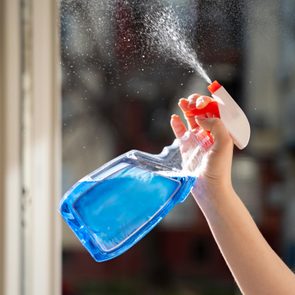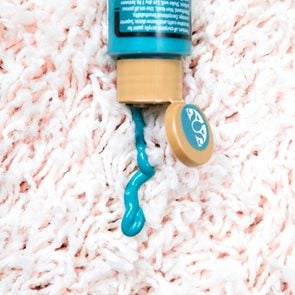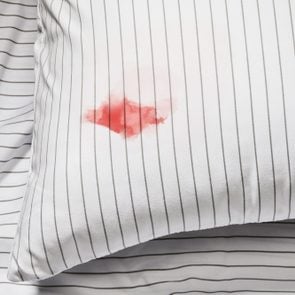How to Get Blood Out of Carpet: 6 Methods Cleaning Experts Rely On
Updated: Jun. 05, 2024

Do your floors need first aid? Don't panic! Here's how to get blood out of carpet, according to the pros.
Stains can be a pain, to be sure. But blood stains? Those are an entirely different challenge. Between my kids’ nose bleeds, the occasional cooking mishap and myriad other accidents, I’m no stranger to blood stains. And when those stains end up on the carpet, it can feel like a monumental disaster. But after nearly 15 years as a cleaning editor, I’ve learned that with the right know-how and an arsenal of supplies at the ready, blood stains don’t stand a chance. If you’ve ever needed to know how to get blood out of carpet, consider this your go-to guide. Because when you know how to remove stains the right way, life’s little disasters will feel, well, less disastrous.
We spoke to three cleaning experts and carpet and upholstery professionals for step-by-step instructions on removing both fresh and dried blood stains. As with any stain treatment that’s part of your cleaning schedule, experts recommend testing your chosen method in an inconspicuous spot first to make sure it doesn’t damage or discolor your carpet. (The carpet in the corner of a closet would be a great out-of-the-way option.) Read on to learn their tips and tricks.
Get Reader’s Digest’s Read Up newsletter for more cleaning, humor, travel, tech and fun facts all week long.
|
On This Page About the experts
|
How to get fresh blood out of carpet
Blood starts off as a spot (something on the surface of the carpet’s fibers), but as it dries over time, that spot can become a stain, which is a more permanent discoloration inside the carpet fibers, points out Jeff Cross, an IICRC-approved instructor for carpet and upholstery care. A quick response is key to ensuring an equally quick cleanup.
Once you’ve bandaged whatever pet or person was the source of the blood stain, assess what carpet-cleaning supplies you have handy and act fast. A fresh spot is much easier to take care of than a dried blood stain. According to Linda Cobb, known as the Queen of Clean, you’ll want to start with plain old lukewarm water (step 1 below) and a white cloth. If the stain persists, you can move on to any of the other solutions. Here are six expert-approved ways to remove fresh blood stains.
1. Water
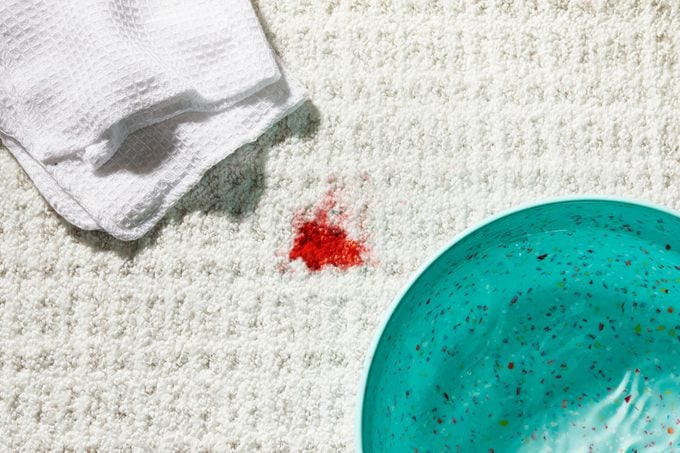
Supplies you’ll need
- Warm water
- White cloths or paper towels
Directions
- Using a dry cloth or paper towel, blot the stain to soak up as much of the organic liquid as you can first.
- Dip a fresh cloth in warm water and blot at the blood stain. Be sure to blot up and down rather than rub at the stain, as rubbing could cause the stain to penetrate deeper into the carpet or damage the fibers—making the discoloration more visible. As you blot, work from the outside of the spot toward the center to keep the stain from expanding.
- Continue blotting until no more blood is transferred to the cloth.
- If further stain treatment is required, continue with one of the options below.
| ♦ Expert cleaning tip |
|
Use white cloths. According to all three of our experts, white cloths are preferred for stain removal, as there’s no risk of dye transfer to whatever surface you’re cleaning, like there might be with a colored rag. Plus, a white cloth allows you to see what discoloration you’re pulling out of the surface. |
2. Hydrogen peroxide
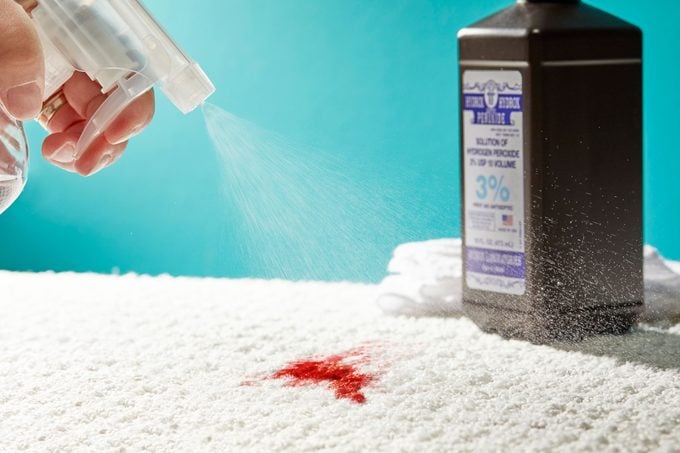
Supplies you’ll need
- 3% hydrogen peroxide
- Spray bottle
- White cloths
Directions
- Add the hydrogen peroxide to a spray bottle.
- Spray the stain with a hydrogen peroxide mist and let it sit for up to an hour. It will likely foam up (like it would if you sprayed a fresh cut on your finger). But this bubbly reaction will actually help lift the stain from the fibers. According to Cross, who says that hydrogen peroxide is his first choice for blood-stain removal, the process adds oxygen and “burns” away the stain.
- When the stain is no longer visible, blot the carpet with a clean cloth to remove the peroxide and assess if further treatment is required.
3. Dish soap
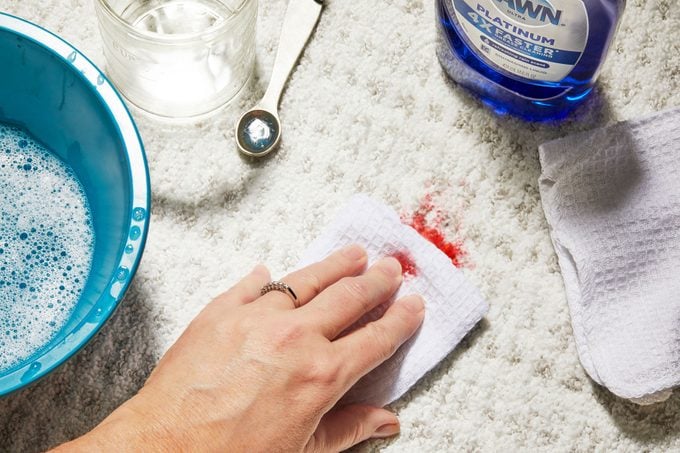
Supplies you’ll need
- Dish soap
- Warm water
- White cloths
Directions
- Combine 1/4 teaspoon of dish soap to 1 cup of lukewarm water.
- Dip a cloth in the solution and apply it to the stain, working from the outside in to the center of the spot.
- Allow the solution to sit for a few minutes, then blot.
- Repeat the steps above if discoloration persists.
- Remove any detergent residue using a fresh rag and lukewarm water.
- Follow with a dry cloth to absorb as much of the liquid as possible. “Excess wetting can cause the carpet backing to delaminate,” says Richard Turner, director of technical services and programs at the Carpet and Rug Institute.
| ♦ Expert cleaning tip |
|
Don’t use super-hot water. Just like when you’re washing dishes, warm water can help break down debris faster than cold water. But make sure it’s not too hot, says Cobb, as super-high heat can actually set the stain into your carpet for good, she says. Limit the water temp to lukewarm. |
4. Ammonia
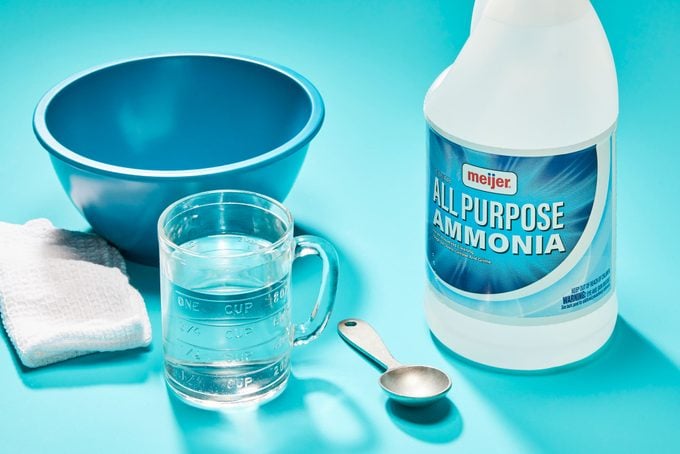
Supplies you’ll need
- Household ammonia
- Water
- White cloths
Directions
- Mix 1 tablespoon of ammonia per 1 cup of water. (Note: Ammonia should be used with caution, as it could cause a color change in the carpet if used improperly. It should also never be mixed with bleach, as the combination is toxic.)
- Dip a cloth in the solution and apply it to the stain, working from the outside in to the center of the spot.
- Blot dry.
5. Salt
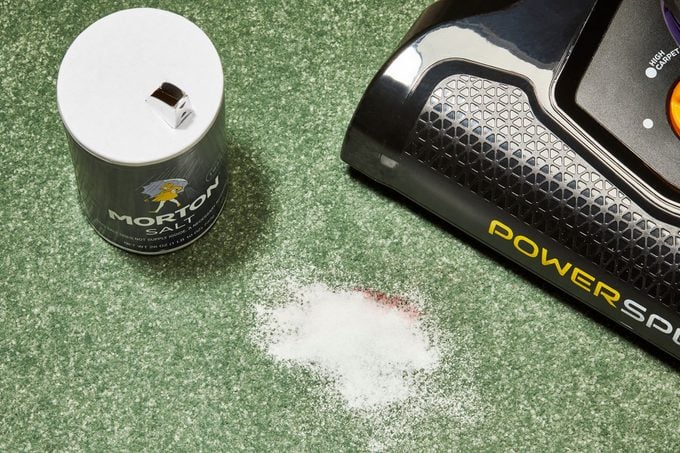
Supplies you’ll need
- Table salt
- Vacuum
Directions
- Cover the stain with a liberal amount of table salt and leave it to dry. The salt will absorb the liquid.
- Vacuum up the salt, and the stain should disappear along with it. (This absorbent method also works for fresh coffee stains as well as red wine stains.)
6. Club soda
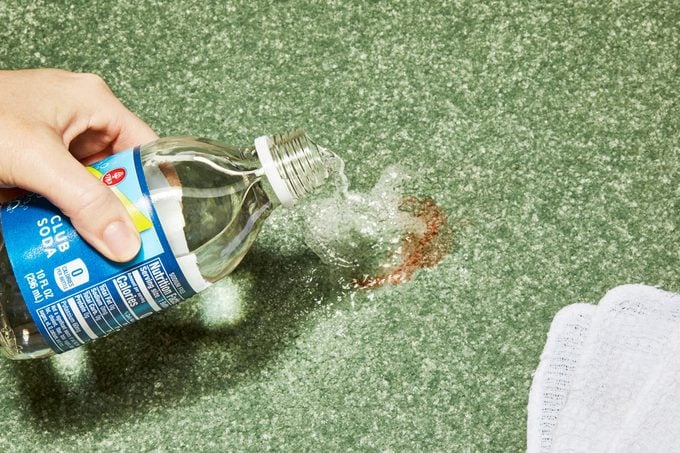
Supplies you’ll need
- Club soda
- White cloths
Directions
- Soak the stain with club soda. The carbonation will help lift the stain from the carpet’s fibers while the salt in the liquid helps prevent the stain from setting.
- Blot with a cloth to remove as much of the moisture as you can. Use a new, dry cloth and apply more pressure to help absorb excess liquid. The stain should lift along with the moisture.
| ♦ Expert cleaning tip |
|
Dry the carpet. You can’t be sure a stain is completely gone until the carpet fibers are fully dry, says Cross. He suggests using towels and a fan to help speed up the drying process. Any stain you may have missed will wick to the surface of the carpet fibers. If this happens, repeat the stain-removal process. |
How to get dried blood out of carpet
While it’s best to tackle the blood stain as quickly as possible, sometimes we don’t find the spots until they’ve well and truly dried. This just means you’ll have to do a little prep work before tackling the stain once and for all. And similar to removing dried blood stains from clothing, you’ll likely need something stronger than water.
Supplies you’ll need
- Spoon, credit card or similar tool
- Vacuum
- White cloths
- One of the above cleaning methods
Directions
- Using a spoon, credit card or another non-absorbent tool, break up any dried blood.
- Vacuum up the solid debris.
- Depending on the supplies you have on hand, follow with one of the stain removal solutions above.
You may need to use a little more cleaning solution on a dried blood stain than you would on a fresh stain to rewet it for removal. If you choose hydrogen peroxide, just note that a dried blood stain may not foam up like a fresh stain would. And if you choose the salt method, you’ll want to dampen the dried blood stain with water to rehydrate it before using the salt to absorb the discoloration.
More tips for removing blood from carpet
I’ve said it before, but it’s worth repeating: The sooner you can tackle blood stains, the less of a chore stain removal is likely to be. Beyond that, follow these additional tips from the pros to help ensure success.
Avoid detergents
Experts do not recommend using laundry detergents or automatic dishwashing detergents on carpet. According to Turner, optical brighteners in some laundry detergents can dye carpet fibers, while many automatic dishwashing detergents contain bleaching agents.
Try a spot removal machine
If you own a portable carpet cleaner, use it, says Cross. It will help extract as much moisture from the carpet fibers as possible in a short amount of time, so you can determine if another spot treatment is necessary.
A warning about wool
Wool carpets tend to be more delicate than nylon. Use a product made specifically for wool, advises Cross, so as not to damage the fibers or cause discoloration. Alternatively, call in a professional.
Why trust us
At Reader’s Digest, we’re committed to producing high-quality content by writers with expertise and experience in their field, in consultation with relevant, qualified experts. For this piece, Stephanie Sisco tapped her experience as a longtime home and cleaning editor. Then fabric-care and stain-removal expert Mary Marlowe Leverette gave it a rigorous review to ensure that all information is accurate and offers the best possible advice to readers. For this piece, we relied on reputable primary sources, including cleaning and health experts and reputable organizations. We verified all facts and data and backed them with credible sourcing, and we will revisit them over time to ensure they remain accurate and up to date. Read more about our team, our contributors and our editorial policies.
Sources:
- Linda Cobb, the Queen of Clean; email interview, Jan. 9, 2024
- Jeff Cross, media director at International Sanitary Supply Association and IICRC-approved instructor for carpet and upholstery care; email interview, Jan. 4, 2024
- Richard Turner, director of technical services and programs at The Carpet and Rug Institute; email interview, Jan. 8, 2024






















